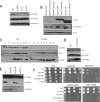Chaperone control of the activity and specificity of the histone H3 acetyltransferase Rtt109
- PMID: 18458063
- PMCID: PMC2447148
- DOI: 10.1128/MCB.00182-08
Chaperone control of the activity and specificity of the histone H3 acetyltransferase Rtt109
Abstract
Acetylation of Saccharomyces cerevisiae histone H3 on K56 by the histone acetyltransferase (HAT) Rtt109 is important for repairing replication-associated lesions. Rtt109 purifies from yeast in complex with the histone chaperone Vps75, which stabilizes the HAT in vivo. A whole-genome screen to identify genes whose deletions have synthetic genetic interactions with rtt109Delta suggests Rtt109 has functions in addition to DNA repair. We show that in addition to its known H3-K56 acetylation activity, Rtt109 is also an H3-K9 HAT, and we show that Rtt109 and Gcn5 are the only H3-K9 HATs in vivo. Rtt109's H3-K9 acetylation activity in vitro is enhanced strongly by Vps75. Another histone chaperone, Asf1, and Vps75 are both required for acetylation of lysine 9 on H3 (H3-K9ac) in vivo by Rtt109, whereas H3-K56ac in vivo requires only Asf1. Asf1 also physically interacts with the nuclear Hat1/Hat2/Hif1 complex that acetylates H4-K5 and H4-K12. We suggest Asf1 is capable of assembling into chromatin H3-H4 dimers diacetylated on both H4-K5/12 and H3-K9/56.
Figures






Similar articles
-
Chaperone-mediated acetylation of histones by Rtt109 identified by quantitative proteomics.J Proteomics. 2013 Apr 9;81:80-90. doi: 10.1016/j.jprot.2012.09.026. Epub 2012 Oct 2. J Proteomics. 2013. PMID: 23036725 Free PMC article.
-
Utilizing targeted mass spectrometry to demonstrate Asf1-dependent increases in residue specificity for Rtt109-Vps75 mediated histone acetylation.PLoS One. 2015 Mar 17;10(3):e0118516. doi: 10.1371/journal.pone.0118516. eCollection 2015. PLoS One. 2015. PMID: 25781956 Free PMC article.
-
Two factor authentication: Asf1 mediates crosstalk between H3 K14 and K56 acetylation.Nucleic Acids Res. 2019 Aug 22;47(14):7380-7391. doi: 10.1093/nar/gkz508. Nucleic Acids Res. 2019. PMID: 31194870 Free PMC article.
-
Understanding histone acetyltransferase Rtt109 structure and function: how many chaperones does it take?Curr Opin Struct Biol. 2011 Dec;21(6):728-34. doi: 10.1016/j.sbi.2011.09.005. Epub 2011 Oct 23. Curr Opin Struct Biol. 2011. PMID: 22023828 Free PMC article. Review.
-
Histone-modifying enzymes, histone modifications and histone chaperones in nucleosome assembly: Lessons learned from Rtt109 histone acetyltransferases.Crit Rev Biochem Mol Biol. 2015 Jan-Feb;50(1):31-53. doi: 10.3109/10409238.2014.978975. Epub 2014 Nov 3. Crit Rev Biochem Mol Biol. 2015. PMID: 25365782 Free PMC article. Review.
Cited by
-
Histone chaperones Nap1 and Vps75 regulate histone acetylation during transcription elongation.Mol Cell Biol. 2013 Apr;33(8):1645-56. doi: 10.1128/MCB.01121-12. Epub 2013 Feb 11. Mol Cell Biol. 2013. PMID: 23401858 Free PMC article.
-
Stoichiometry of Rtt109 complexes with Vps75 and histones H3-H4.Life Sci Alliance. 2020 Sep 10;3(11):e202000771. doi: 10.26508/lsa.202000771. Print 2020 Nov. Life Sci Alliance. 2020. PMID: 32913112 Free PMC article.
-
Rtt109 prevents hyper-amplification of ribosomal RNA genes through histone modification in budding yeast.PLoS Genet. 2013 Apr;9(4):e1003410. doi: 10.1371/journal.pgen.1003410. Epub 2013 Apr 4. PLoS Genet. 2013. PMID: 23593017 Free PMC article.
-
A nucleosomal surface defines an integration hotspot for the Saccharomyces cerevisiae Ty1 retrotransposon.Genome Res. 2012 Apr;22(4):704-13. doi: 10.1101/gr.129585.111. Epub 2012 Jan 4. Genome Res. 2012. PMID: 22219511 Free PMC article.
-
Individual lysine acetylations on the N terminus of Saccharomyces cerevisiae H2A.Z are highly but not differentially regulated.J Biol Chem. 2010 Dec 17;285(51):39855-65. doi: 10.1074/jbc.M110.185967. Epub 2010 Oct 14. J Biol Chem. 2010. PMID: 20952395 Free PMC article.
References
-
- Adkins, M. W., J. J. Carson, C. M. English, C. J. Ramey, and J. K. Tyler. 2007. The histone chaperone anti-silencing function 1 stimulates the acetylation of newly synthesized histone H3 in S-phase. J. Biol. Chem. 2821334-1340. - PubMed
-
- Adkins, M. W., and J. K. Tyler. 2004. The histone chaperone Asf1p mediates global chromatin disassembly in vivo. J. Biol. Chem. 27952069-52074. - PubMed
-
- Ai, X., and M. R. Parthun. 2004. The nuclear Hat1p/Hat2p complex: a molecular link between type B histone acetyltransferases and chromatin assembly. Mol. Cell 14195-205. - PubMed
Publication types
MeSH terms
Substances
LinkOut - more resources
Full Text Sources
Molecular Biology Databases
Research Materials
